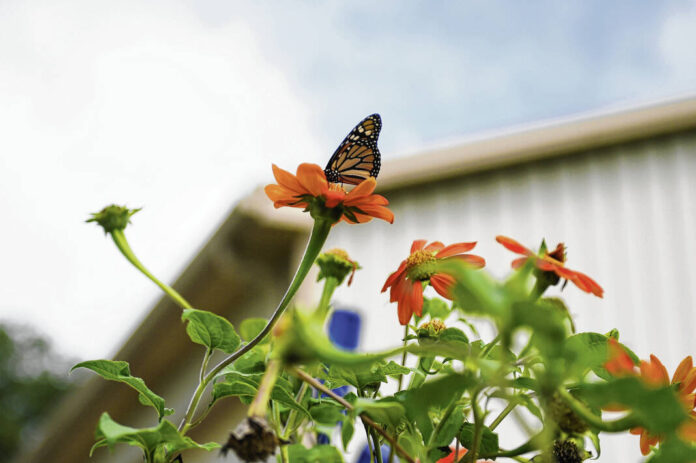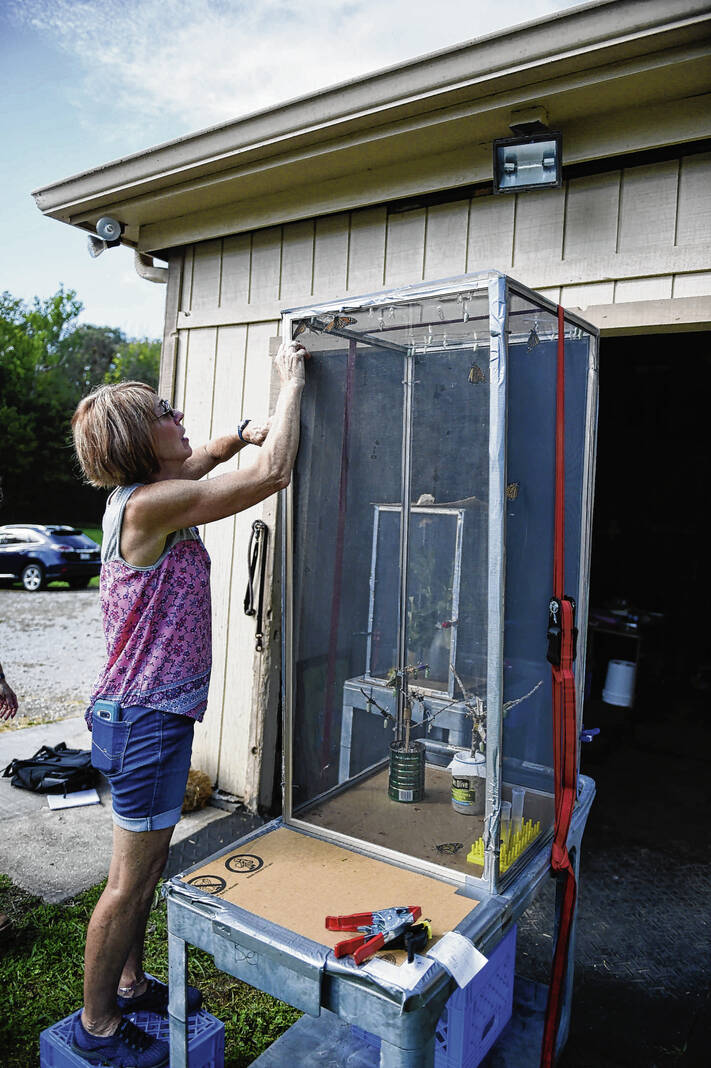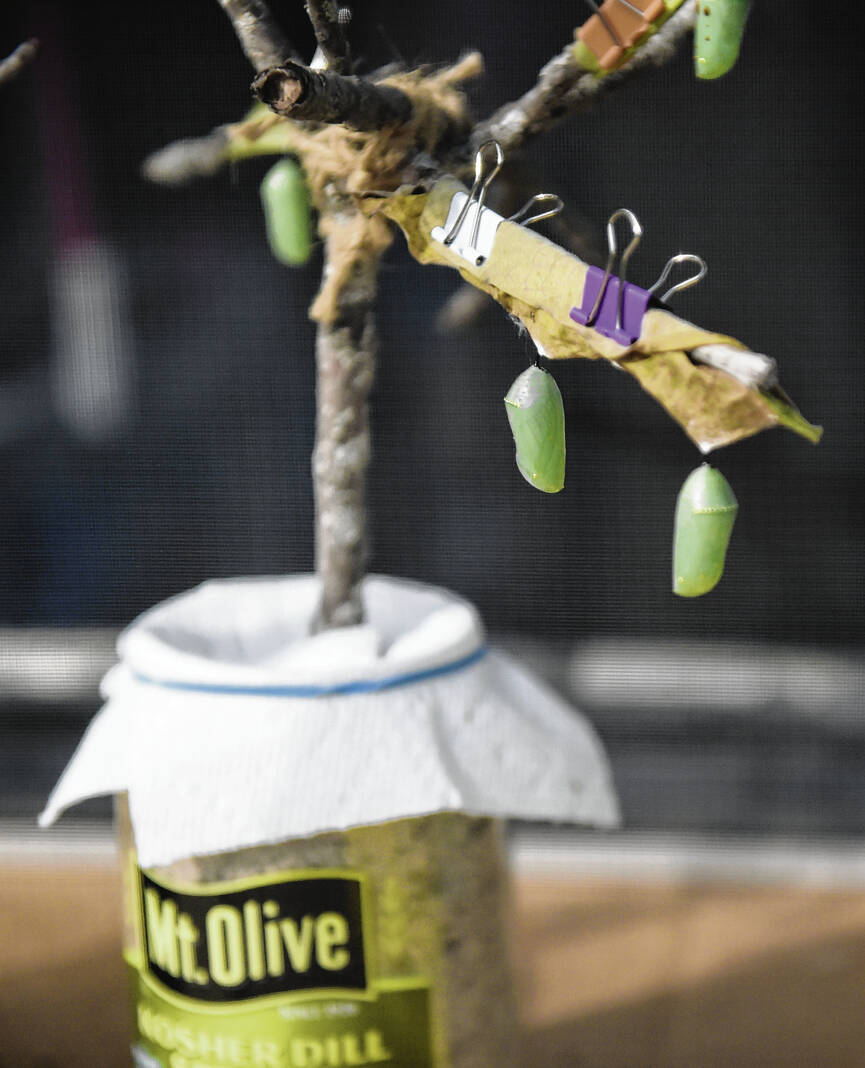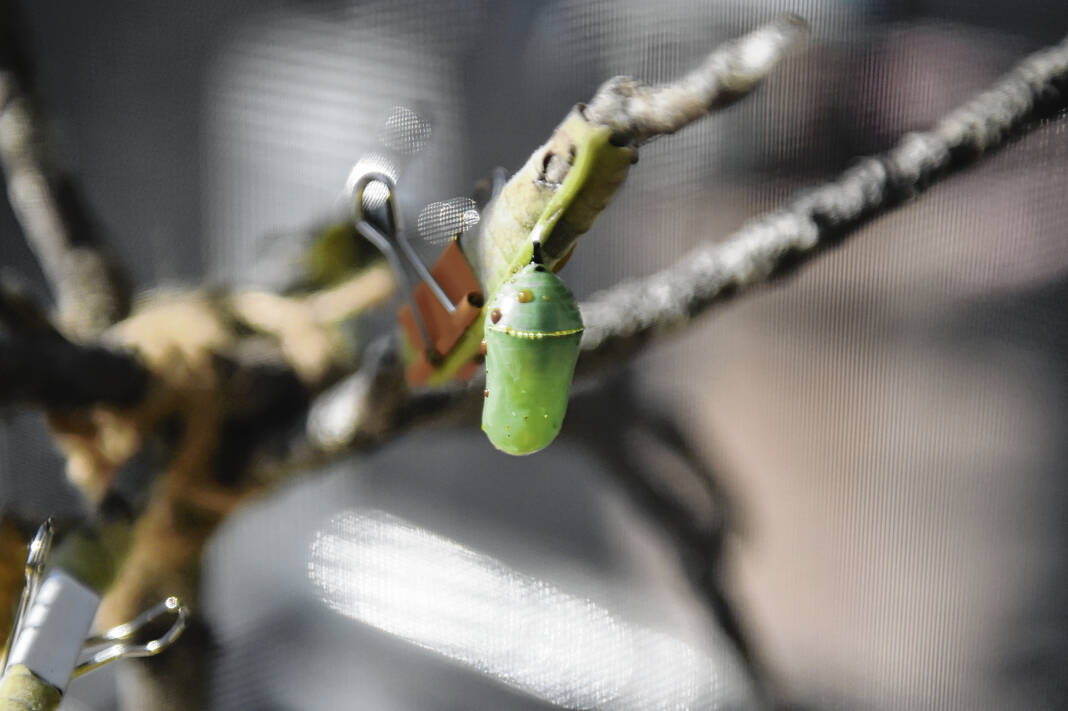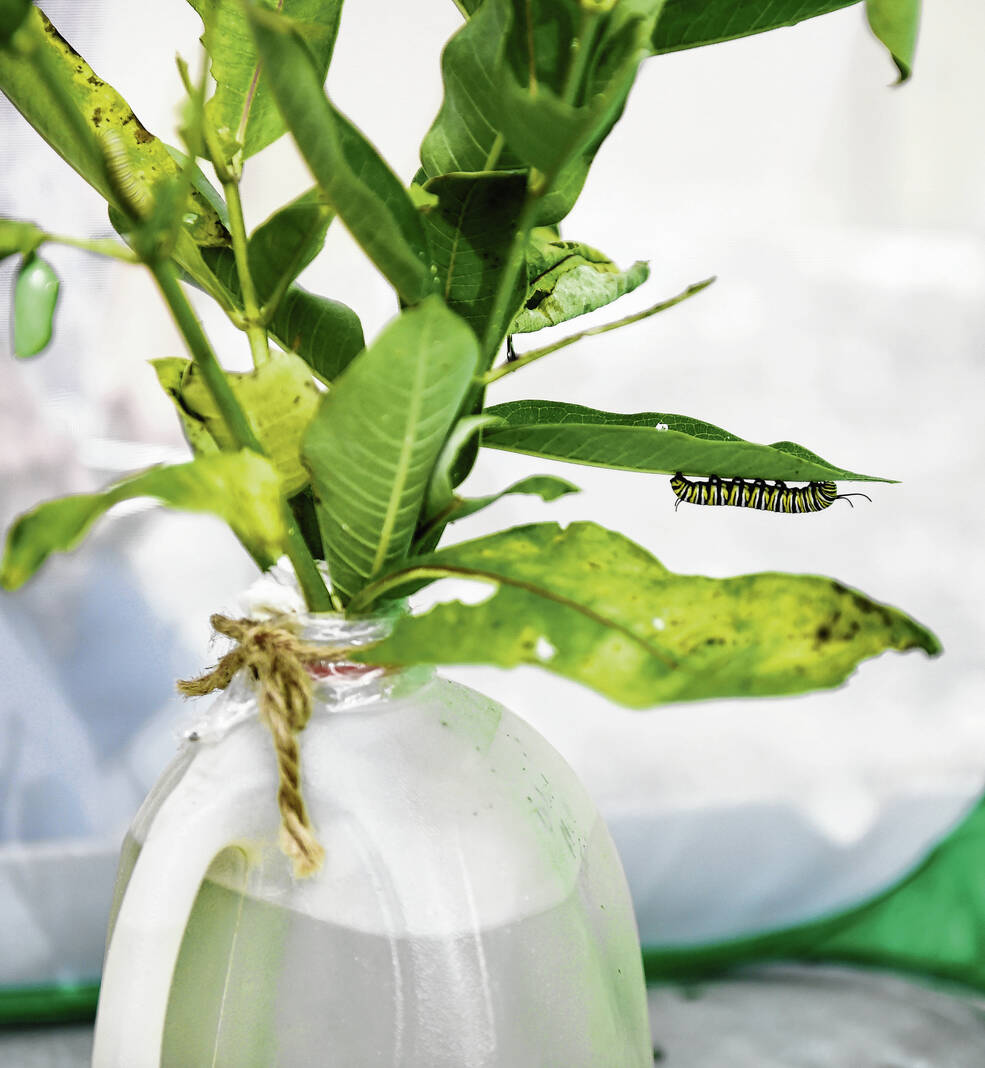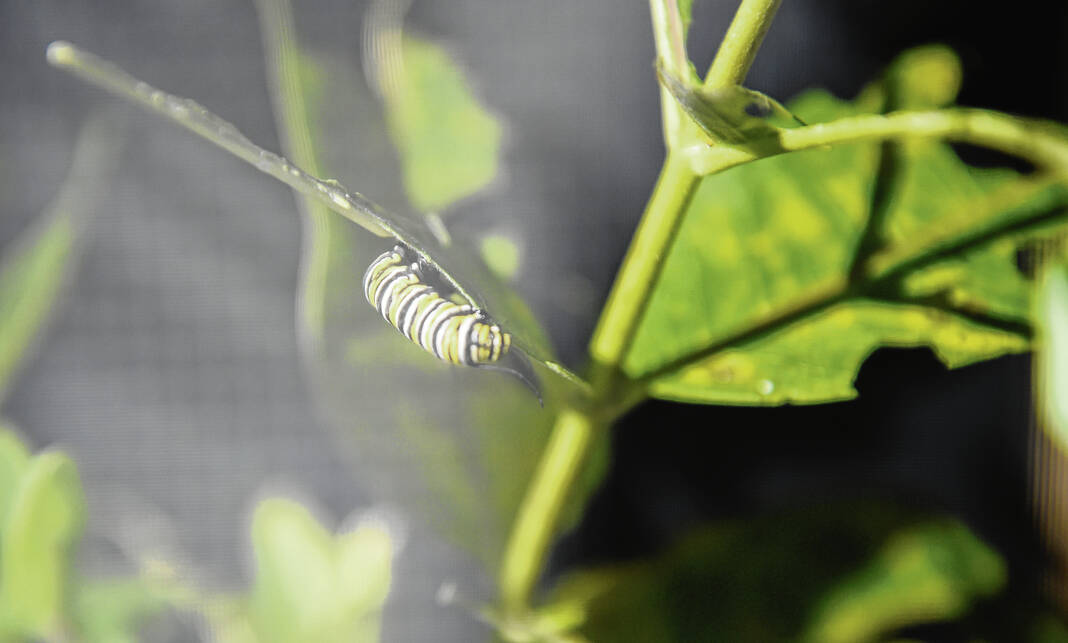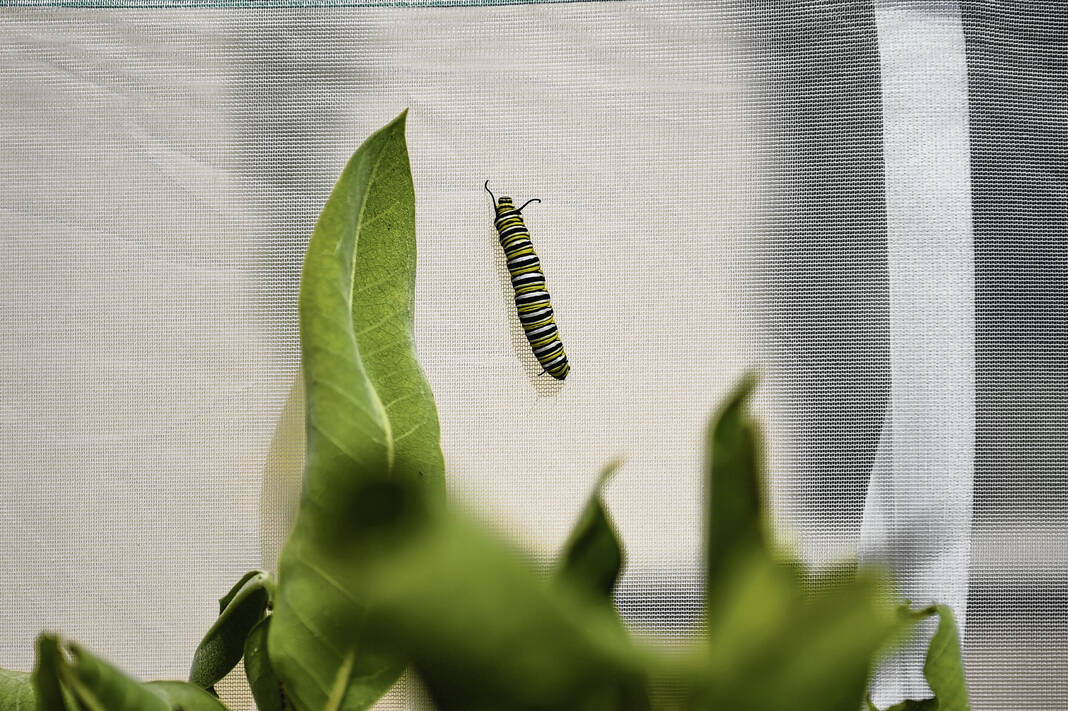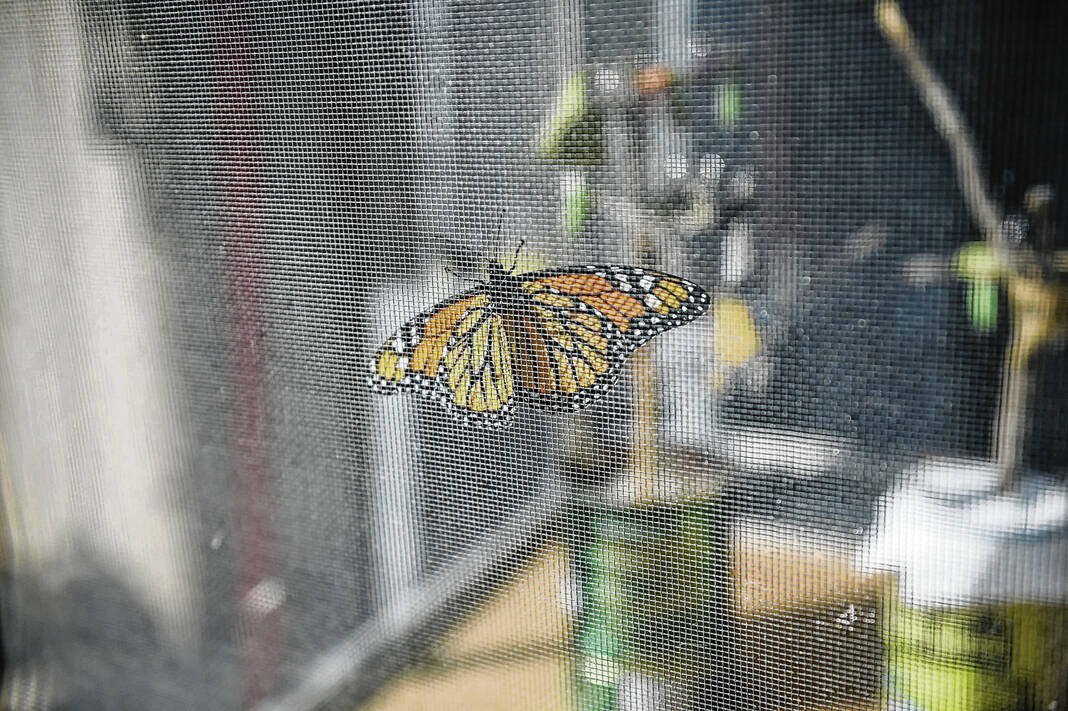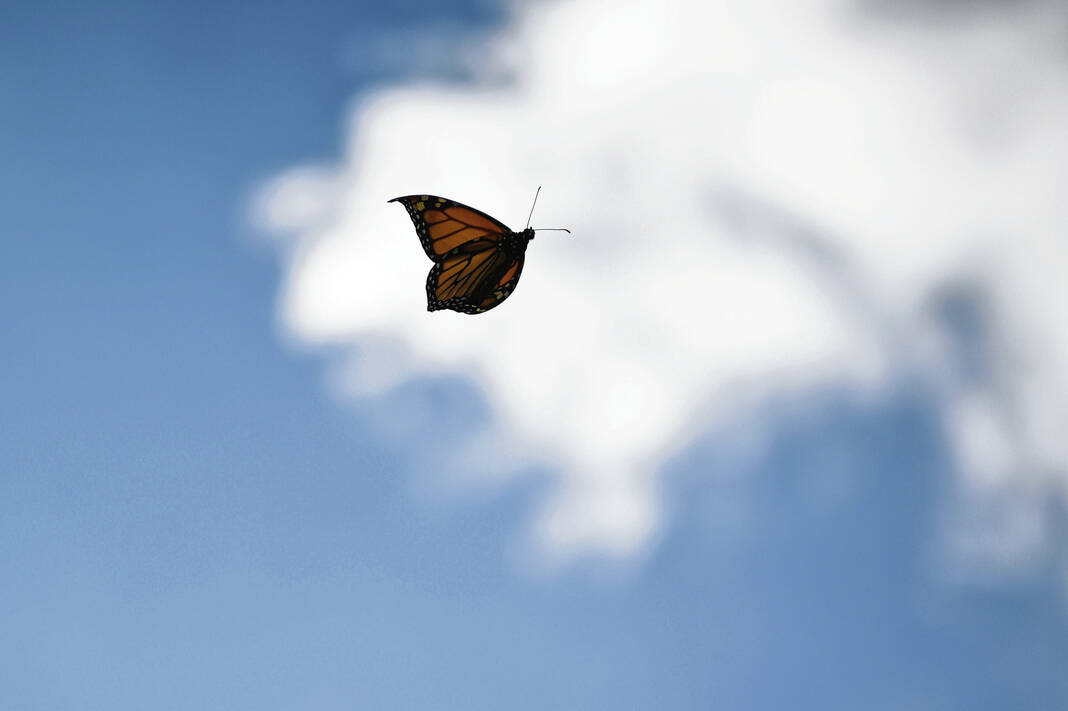The first few feet of a 2,000-mile journey were wobbly, fluttering ride on the breeze.
Freshly out of its chrysalis, the monarch butterfly awkwardly flapped its wings in the open air for the first time, building strength and momentum before flying off into the Bargersville countryside. In the coming months, the butterfly would try to migrate to its wintering grounds in central Mexico.
On the ground, a quartet of monarch enthusiasts watched with excitement, shouting encouragement as the butterfly took off.
“They’re like your foster children until you let them go. It’s so exciting,” said Barb Mickler, owner of the farm where the monarchs were being released.
Mickler and a group from the Johnson County Garden Club are part of a growing number of local residents doing all they can to support monarch butterflies. The embattled insects are seeing their populations plummet as development, pesticides and deforestation threaten their habitats and destroy their main food source.
“To help, you don’t have to have a large yard,” said Deb Howson, a local master gardener and member of the Johnson County Garden Club. “There are several different kinds of milkweed that you can plant, and other annuals and perennials that you can plant to feed the butterflies. You can do a lot of different things.”
Monarch butterflies are in big trouble. The insects were added to the Red List of Threatened Species by the International Union for Conservation of Nature in July. The list is the world’s most comprehensive information source on the global extinction risk status of animal, fungus and plant species.
Migratory monarch butterflies are one of nature’s most marvelous and powerful creatures. The butterflies travel from the northern United States — including Indiana — and southern Canada to their overwintering destination in central Mexico.
“These ones here, they have no clue what Mexico is other than its somewhere in its DNA. Their whole existence is to know where they’re going,” Howson said.
At the Monarch Butterfly Biosphere Reserve in Michoacán, Mexico, millions of monarchs fill a certain type of fir tree, the oyamel tree, according to the World Wildlife Federation.
By the start of spring, monarchs are ready to mate and migrate back to the U.S. They fly another 1,000 miles to lay their eggs solely on milkweed plants, which will eventually serve as a food source for the caterpillars.
But the destruction of milkweed has emperiled the insects. That caught Mickler’s attention.
Monarch mission
A few years ago, she noticed that milkweed plants on her and her husband’s farm in Bargersville were getting torn up every time they cut hay. Knowing the importance of the plant to monarchs, she started cutting the milkweed down and moving it to their barn.
When she found monarch eggs, she would transplant them to habitat — simple containers made of wood and mesh wire — to monitor and replenish with fresh milkweed.
“You kind of scramble to get this stuff together. One year, I had only found 10. Then the next year, we found 50, so that’s a big jump,” she said.
This year, she only found three caterpillars during the early cutting. She had heard from experts and others she had connected with about the monarchs that their numbers were severely down this year, and was worried that the low number of eggs were a result of that.
But about four weeks ago, pulling new milkweed in from the fields, she was up to about 80 caterpillars.
“So we scrambled and put together new habitats and picked more milkweed to put into milk jugs, transferring them into habitats,” she said.
Still, Mickler had run into a dilemma. She was going on vacation in the summer, right as the caterpillars were at the most integral part of their development. They needed constantly refreshed milkweed; the caterpillars can go through an entire milkweed leaf in just five minutes, according to to Save Our Monarchs.
But milkweed dries out quickly once cut, and the caterpillars don’t get as many nutrients from the plant then. She didn’t know what to do.
“I had all of these eating caterpillars, and I’d saved them from being put in a bale of hay, and now I have to feed them,” she said. “They need cared for, and it’s usually twice a day, especially in their last stage of life, before they turn.”
Mickler turned to Purdue Extension Johnson County.
She had first interacted with Purdue Extension with questions about her rhododendron bush. Howson, a master gardener, came out to help her. When they started talking, they realized that they both foster monarchs.
“They next thing I know, Barb’s going on vacation. You can try to fill it with milkweed, but it doesn’t last more than a few days,” Howson said.
Howson, also a member of the Johnson County Garden Club, had their president put a call-out to members for help, asking if anyone would be willing to come help feed and care for the caterpillars while she was gone.
Fellow garden club members Linda Pfeiffer and Ellen Miller responded. Miller had fostered swallowtail butterflies in the past. Pfeiffer had never done so either, but wanted to learn.
“We would pick the week that she was on vacation, and pick fresh milkweed, and you’d see eggs and more caterpillars. Every one you save is one that doesn’t get eaten by a bird or another predator,” she said.
Their work — picking milkweed, cleaning the habitats, watching for any developments — worked. Throughout August and September, chrysalises have appeared throughout the habitats, and the monarchs have emerged in droves. Once the butterflies stretch and dry off their wings, and are ready to fly, they are released on their own — hopefully beginning their journey to Mexico.
Small actions, big impact
Mickler, Howson, Pfeiffer and Miller all hope their efforts show others how simple additions to their yards and properties can help support the monarch population.
Planting patches of milkweed is one way to do it. A variety of different species are available, from the tall and spindly common milkweed to slender swamp milkweed to the colorful annual Mexican butterfly bush or tropical milkweed.
But cultivating gardens full of nectar-rich plants that bloom in late summer and fall is also key, Howson said.
“They need the energy to continue on their journey. So that’s why there’s been a lot of states and groups that have developed pollinator gardens that bloom in the fall. That will keep them nourished as they travel,” she said. “That’s what we’re hoping, as a whole, that throughout the United States we’re doing everything we can.”
Perennials such as xenia and Mexican sunflower, as well as annuals such as lantana and salvia are ideal species to plant, Mickler said.
“You can have so many perennials, so many annuals, spring to fall. I like to focus on the fall, because they are late to get here in the spring, but they really need a big source in the fall,” she said.
Monarch butterflies are not only beautiful to look at, but are important in pollinating other plants and supporting the wider ecosystem.
“They are important to our food supply, they’re important to our ecosystem,” Mickler said. “They face so many dangers and face so many predators, and then just windshields and herbicides and pesticides. We want to be part of establishing that trailway for monarchs to have that milkweed.”
How to help
To create a habitat for monarchs, people need to provide milkweeds for the larvae, nectar plants for the adults, and sufficient vegetation to provide shelter for the larvae, pupae and adults.
Local residents hoping to help support monarch butterflies and create gardens to ensure they thrive can go to the following resources:
The Johnson County Soil and Water Conservation District Little Native Seed Library Trail: A collection of seven locations across Johnson County that will show the beauty and diversity of plants native to Indiana through landscaping. There are seed packets that reflect the landscape you are at within the library for you to take home to use on your own property if you so wish; jocoswcd.org/librarytrail.
Save Our Monarchs: A grassroots non-profit organization dedicated to saving the monarch butterflies, helping distribute milkweed seeds and working with other gardeners to ensure the seeds are planted and cared-for properly; saveourmonarchs.org.
Indiana Monarch and Pollinator Conservation Hub: An effort by the Indiana Wildlife Federation to provide an online resource that would act as a clearinghouse for Indiana monarch and pollinator conservation data, research, best management practices and events; indianawildlife.org/monarchs.
Journey North: An organization dedicated to creating a community contributing observational data and acting as conservation and protection of migratory species, including monarch butterflies; journeynorth.org/monarchs.
Monarch Watch: A nonprofit a nonprofit education, conservation, and research program based at the University of Kansas that focuses on the monarch butterfly, its habitat, and its fall migration; monarchwatch.org.


